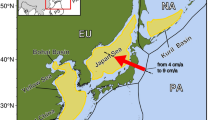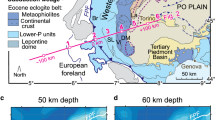Abstract
Because the inertia of tectonic plates is negligible, plate velocities result from the balance of forces acting at plate margins and along their base1. Observations of past plate motion derived from marine magnetic anomalies provide evidence of how continental deformation may contribute to plate driving forces2,3,4,5,6,7,8. A decrease in convergence rate at the inception of continental collision is expected because of the greater buoyancy of continental than oceanic lithosphere2,3, but post-collisional rates are less well understood. Slowing of convergence has generally been attributed to the development of high topography that further resists convergent motion7,8,9,10; however, the role of deforming continental mantle lithosphere on plate motions has not previously been considered. Here I show that the rate of India’s penetration into Eurasia has decreased exponentially since their collision. The exponential decrease in convergence rate suggests that contractional strain across Tibet has been constant throughout the collision at a rate of 7.03 × 10−16 s−1, which matches the current rate. A constant bulk strain rate of the orogen suggests that convergent motion is resisted by constant average stress (constant force) applied to a relatively uniform layer or interface at depth. This finding follows new evidence that the mantle lithosphere beneath Tibet is intact11, which supports the interpretation that the long-term strain history of Tibet reflects deformation of the mantle lithosphere. Under conditions of constant stress and strength, the deforming continental lithosphere creates a type of viscous resistance that affects plate motion irrespective of how topography evolved.
This is a preview of subscription content, access via your institution
Access options
Subscribe to this journal
Receive 51 print issues and online access
$199.00 per year
only $3.90 per issue
Buy this article
- Purchase on Springer Link
- Instant access to full article PDF
Prices may be subject to local taxes which are calculated during checkout



Similar content being viewed by others
References
Forsyth, D. & Uyeda, S. On the relative importance of the driving forces of plate motion. Geophys. J. R. Astron. Soc. 43, 163–200 (1975)
Patriat, P. & Achache, J. India–Eurasia collision chronology has implications for crustal shortening and driving mechanisms of plates. Nature 311, 615–621 (1984)
Dewey, J., Cande, S. & Pitman, W. C. Tectonic evolution of the India Eurasia collision zone. Eclogae Geol. Helv. 82, 717–734 (1989)
McQuarrie, N., Stock, J. M., Verdel, C. & Wernicke, B. P. Cenozoic evolution of Neotethys and implications for the causes of plate motions. Geophys. Res. Lett. 30, 2026 (2003)
Garzione, C., Molnar, P., Libarkin, J. C. & MacFadden, B. J. Rapid late Miocene rise of the Bolivian Altiplano: evidence for removal of the mantle lithosphere. Earth Planet. Sci. Lett. 241, 543–556 (2006)
Meade, B. & Conrad, C. Andean growth and the deceleration of South American subduction: time evolution of a coupled orogen-subduction system. Earth Planet. Sci. Lett. 275, 93–101 (2008)
Molnar, P. & Stock, J. M. Slowing of India’s convergence with Eurasia since 20 Ma and its implications for Tibetan mantle dynamics. Tectonics 28, TC3001 (2009)
Copley, A., Avouac, J.-P. & Royer, J.-Y. India–Asia collision and the Cenozoic slowdown of the Indian plate: implications for the forces driving plate motions. J. Geophys. Res. 115, B03410 (2010)
Artyushkov, E. V. Stresses in the lithosphere caused by crustal thickness inhomogeneities. J. Geophys. Res. 78, 7675–7708 (1973)
Molnar, P. & Lyon-Caen, H. Some simple physical aspects of the support, structure and evolution of mountain belts. Spec. Pap. Geol. Soc. Am. 218, 179–207 (1988)
McKenzie, D. & Priestley, K. The influence of lithospheric thickness variations on continental evolution. Lithos 102, 1–11 (2008)
Rowley, D. Age of initiation of collision between India and Asia: a review of stratigraphic data. Earth Planet. Sci. Lett. 145, 1–13 (1996)
Merkouriev, S. & DeMets, C. Constraints on Indian plate motion since 20 Ma from dense Russian magnetic data: implications for Indian plate dynamics. Geochem. Geophys. Geosyst. 7, Q02002 (2006)
Merkouriev, S. & DeMets, C. A high-resolution model for Eurasia–North America plate kinematics since 20 Ma. Geophys. J. Int. 173, 1064–1083 (2008)
Flesch, L. M., Haines, A. J. & Holt, W. E. Dynamics of the India–Eurasia collision zone. J. Geophys. Res. 106, 16435–16460 (2001)
Kapp, P., DeCelles, P. G., Gehrels, G. E., Heizler, M. & Ding, L. Geological records of the Lhasa-Qiangtang and Indo-Asian collisions in the Nima area of central Tibet. Geol. Soc. Am. Bull. 119, 917–933 (2007)
Royden, L., Burchfiel, B. C. & van der Hilst, R. D. The geologic evolution of the Tibetan Plateau. Science 321, 1054–1058 (2008)
Clark, M. K., Farley, K. A., Zheng, D. W., Wang, Z. C. & Duvall, A. R. Early Cenozoic faulting of the northern Tibetan Plateau margin from apatite (U-Th)/He ages. Earth Planet. Sci. Lett. 296, 78–88 (2010)
Bally, A. W. Notes on Sedimentary Basins in China. Reports of the American Sedimentary Basins Delegation to the People’s Republic of China. Open File Report USGS 86-327. (1986)
Dupont-Nivet, G. et al. Paleogene clockwise tectonic rotation of the Xining-Lanzhou region, northeastern Tibetan Plateau. J. Geophys. Res. 109, B04401 (2004)
Wang, C. et al. Constraints on the early uplift history of the Tibetan Plateau. Proc. Natl Acad. Sci. USA 105, 4987–4992 (2008)
Yin, A. et al. Tectonic history of the Altyn Tagh fault system in northern Tibet inferred from Cenozoic sedimentation. Geol. Soc. Am. Bull. 114, 1257–1295 (2002)
Fang, X., Garzione, C., Van der Voo, R., Li, J. J. & Fan, M. J. Flexural subsidence by 29 Ma on the NE edge of Tibet from the magnetostratigraphy of Linxia Basin, China. Earth Planet. Sci. Lett. 210, 545–560 (2003)
Studnicki-Gizbert, C., Burchfiel, B. C., Li, Z. & Chen, Z. Early Tertiary Gonjo basin, eastern Tibet: sedimentary and structural record of the early history of India–Asia collision. Geosphere 4, 713–735 (2008)
Spurlin, M. S., Yin, A., Horton, B. K., Zhou, J. & Wang, J. Structural evolution of the Yushu-Nangqian region and its relationship to syncollisional igneous activity, east-central Tibet. Geol. Soc. Am. Bull. 117, 1293–1317 (2005)
Zhang, P. et al. Continuous deformation of the Tibetan Plateau from global positioning system data. Geology 32, 809–812 (2004)
Wang, Q. et al. Present-day crustal deformation in China constrained by global positioning system measurements. Science 294, 574–577 (2001)
Chen, Q. et al. A deforming block model for the present-day tectonics of Tibet. J. Geophys. Res. 109, B01403 (2004)
England, P. & Houseman, G. Extension during continental convergence, with application to the Tibetan Plateau. J. Geophys. Res. 94, 17561–17579 (1989)
England, P., Houseman, G. & Sonder, L. Length scales for continental deformation in convergent, divergent and strike-slip environments—analytical and approximate solutions for a thin viscous sheet model. J. Geophys. Res. 90, 3551–3557 (1985)
Flesch, L. M. et al. 2005, Constraining the extent of crust–mantle coupling in central Asia using GPS, geologic and shear wave splitting data. Earth Planet. Sci. Lett. 238, 248–268 (2005)
Ritts, B. D., Yue, Y. & Graham, S. A. Oligocene–Miocene tectonics and sedimentation along the Altyn Tagh Fault, northern Tibetan Plateau: analysis of the Xorkol, Subei and Aksay basins. J. Geol. 112, 207–229 (2004)
Jolivet, M. et al. Mesozoic and Cenozoic tectonics of the northern edge of the Tibetan plateau: fission-track constraints. Tectonophysics 343, 111–134 (2001)
Burchfiel, B. C. et al. Geology of the Haiyuan fault zone, Ningxia-Hui Autonomous region, China, and its relation to the evolution of the northeastern margin of the Tibetan Plateau. Tectonics 10, 1091–1110 (1991)
Kirby, E. et al. Late Cenozoic evolution of the eastern margin of the Tibetan Plateau: inferences from Ar40/Ar39 and (U-Th)/He thermochronometry. Tectonics 21, 1001 (2002)
Zheng, D. et al. Rapid exhumation at ∼8 Ma on the Liupan Shan thrust fault from apatite thermochronology: implications for growth of the northeastern Tibetan Plateau margin. Earth Planet. Sci. Lett. 248, 198–208 (2006)
Meyer, B. et al. Crustal thickening in Gansu-Qinghai, lithospheric mantle subduction, and oblique, strike-slip controlled growth of the Tibet plateau. Geophys. J. Int. 135, 1–47 (1998)
Yin, A., Dang, Y.-Q., Zhang, M., Chen, X.-H. & McRivette, M. W. Cenozoic tectonic evolution of the Qaidam basin and its surrounding regions (Part 3): Structural geology, sedimentation, and regional tectonic reconstruction. Geol. Soc. Am. Bull. 120, 847–876 (2008)
Duvall, A. R., Clark, M. K., van der Plujim, B. A. & Li, C. Direct dating of Eocene reverse faulting in northeastern Tibet using Ar-dating of fault clays and low-temperature thermochronometry. Earth Planet. Sci. Lett. 304, 520–526 (2011)
Acknowledgements
I thank E. Hetland, N. Lewandowski and P. Molnar for discussions and comments, and P. Molnar and J. Stock for sharing their plate reconstruction data in advance of their publication. I also thank Peizhen Zhang and colleagues for leading our collaborative US–Chinese field efforts and cooperative study. L. Flesch and J. Freymueller provided critical feedback that greatly improved the quality of this manuscript. Support for this research was provided by the National Science Foundation, Continental Dynamics Program (EAR-0549748 and EAR-0908711).
Author information
Authors and Affiliations
Contributions
M.K.C. performed the data analysis, conceived of the proposed model and wrote the manuscript.
Corresponding author
Ethics declarations
Competing interests
The author declares no competing financial interests.
Supplementary information
Supplementary Figures
This file contains Supplementary Figures 1-3 with legends. (PDF 243 kb)
Rights and permissions
About this article
Cite this article
Clark, M. Continental collision slowing due to viscous mantle lithosphere rather than topography. Nature 483, 74–77 (2012). https://doi.org/10.1038/nature10848
Received:
Accepted:
Published:
Issue Date:
DOI: https://doi.org/10.1038/nature10848
This article is cited by
-
Earth’s gradients as the engine of plate tectonics and earthquakes
La Rivista del Nuovo Cimento (2022)
-
Lithospheric foundering and underthrusting imaged beneath Tibet
Nature Communications (2017)
-
Expansion of the Tibetan Plateau during the Neogene
Nature Communications (2017)
-
Evolution and variability of the Asian monsoon and its potential linkage with uplift of the Himalaya and Tibetan Plateau
Progress in Earth and Planetary Science (2016)
-
Constraints on mountain building in the northeastern Tibet: Detrital zircon records from synorogenic deposits in the Yumen Basin
Scientific Reports (2016)
Comments
By submitting a comment you agree to abide by our Terms and Community Guidelines. If you find something abusive or that does not comply with our terms or guidelines please flag it as inappropriate.



